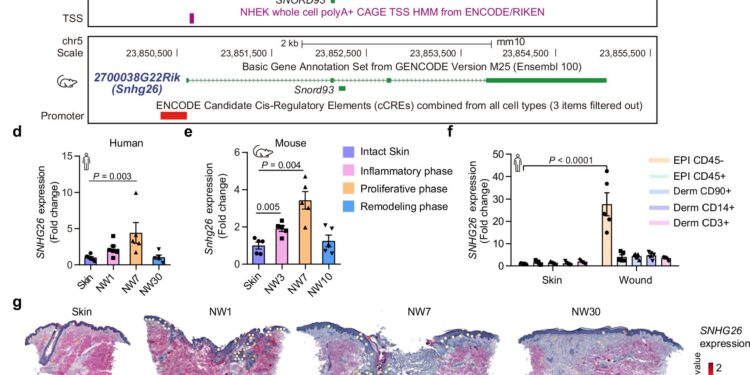ncRNA expression profiling and functional screening in human skin wound healing. Credit: Natural communications (2024). DOI: 10.1038/s41467-024-52783-8
A new study from Karolinska Institutet and the Chinese Academy of Medical Sciences has identified an RNA molecule important for skin wound healing. The research, published in Natural communicationsmay have implications for the treatment of difficult-to-heal wounds.
The study focuses on the molecular processes in wound healing that regulate the transition from inflammation – a key defense mechanism – to a proliferation phase, during which new cells form to repair damaged tissues. Researchers have now mapped lncRNA (long non-coding RNA molecules) in human skin wounds in tissue samples from Karolinska University Hospital, identifying a key regulator in wound healing.
“Our study reveals that the lncRNA molecule SNHG26 plays a central role in guiding skin cells through the stages of wound healing, from an inflammatory stage to a healing phase,” explains Ning Xu Landén, professor at the Department of Medicine of Solna, Karolinska Institutet. .
The researchers also used mouse models to discover how this molecule interacts with genes involved in inflammation and tissue regeneration. In mice lacking SNHG26, wound healing was delayed, highlighting the importance of the molecule in the balance between inflammation and tissue repair. This discovery opens the way to new therapeutic approaches for acute and chronic wounds.
“By targeting SNHG26, we may be able to accelerate healing and reduce complications, particularly in chronic wounds where prolonged inflammation is a major problem,” says Landén.
His research group at Karolinska Institutet studies how skin healing processes are controlled by so-called regulatory RNA molecules, i.e. RNA molecules that regulate gene activity and include both lncRNAs and microRNA molecules now awarded the Nobel Prize. The researchers will now continue to study how other regulatory RNA molecules are involved in tissue repair, with the aim of developing innovative treatments for difficult-to-heal wounds.
The study was carried out in close collaboration with Dongqing Li of the Chinese Academy of Medical Sciences.
More information:
Dongqing Li et al, lncRNA SNHG26 drives the transition from inflammatory to proliferative state of keratinocyte progenitor cells during wound healing, Natural communications (2024). DOI: 10.1038/s41467-024-52783-8
Provided by the Karolinska Institute
Quote: Key molecule in wound healing identified through mapping of long non-coding RNA molecules (October 8, 2024) retrieved October 8, 2024 from
This document is subject to copyright. Except for fair use for private study or research purposes, no part may be reproduced without written permission. The content is provided for informational purposes only.



